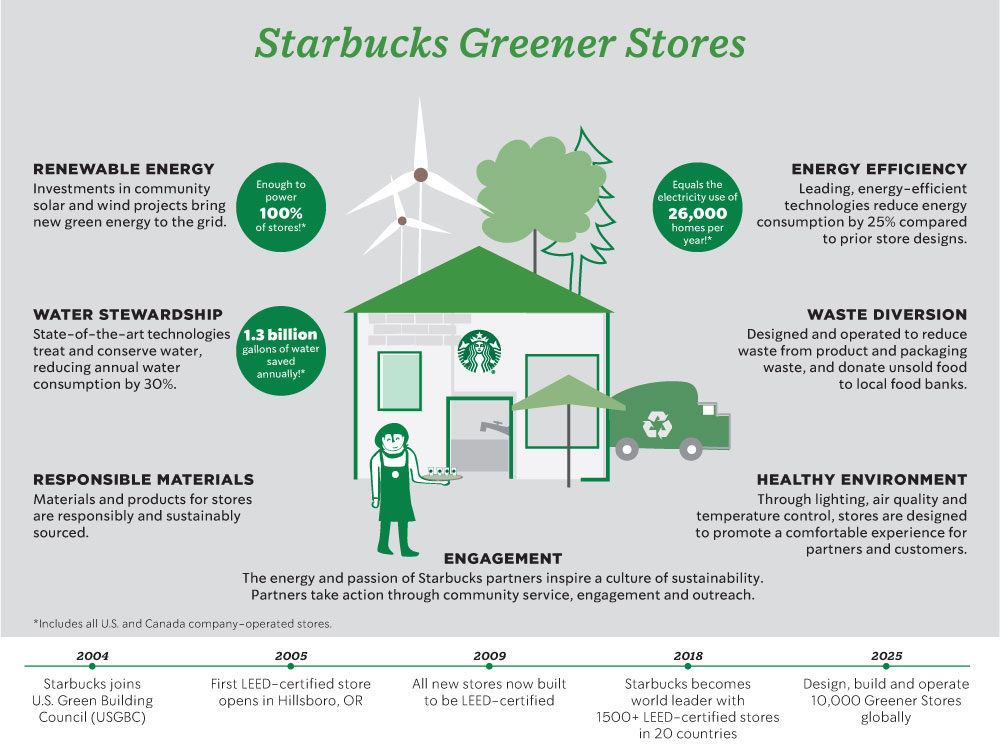Starbucks is going green. Well, the company—as one of the world’s largest retail builder of LEED-certified stores—was already pretty green, but Starbucks announced September 13 that the brand would commit to designing, building, and operating 10,000 of what it calls “Greener Stores” globally by 2025. This will encompass existing stores, new builds, and renovations.
Over 2019, the brand will develop a program to audit existing company-operated stores in the U.S. and Canada against the comprehensive framework criteria.
The “Starbucks Greener Stores” framework is anticipated to save the company an incremental $50 million in utilities over the next 10 years. This builds on its 10-year legacy of utility cost savings attributable to Greener Store practices, which already equates to about $30 million in saved annual operating costs.
These Greener Stores will focus on energy efficiency and water stewardship by deploying technologies and practices that will deliver 30 percent water savings and 25 percent avoided energy over store design practices. Stores will be powered 100 percent by renewable energy from solar and wind projects and be designed and operated to reduce waste and create a comfortable experience that promotes wellness for customers and partners through lighting noise, air quality, and temperature. The stores will also be designed with responsibly sourced materials and products and in a way that engages customers and partners in the cause.
With this effort, Starbucks hopes to set a new standard for green retail.
“Simply put, sustainable coffee, served sustainably is our aspiration,” said Kevin Johnson, president and CEO of Starbucks, in a statement about the new initiative. “We know that designing and building green stores is not only responsible, it is cost effective as well. The energy and passion of our green apron partners has inspired us to find ways to operate a greener store that will generate even greater cost savings while reducing impact.”
Starbucks joined with the U.S. Green Building Council in 2001 to develop the LEED for Retail program and opened its first LEED-certified store in 2005. Today, Starbucks operates more than 1,500 LEED-certified stores globally.
“One of our social impact pillars is sustainability,” Johnson said at the Global Climate Action Summit in San Francisco preceding the announcement. “We are a company that believes, in the fabric of mission and values, that the pursuit of profit is not in conflict with the pursuit of doing good.”

The framework will be co-developed by leading experts, including the World Wildlife Fund, and will be audited and verified by SCS Global Services, a third-party verification organization that also oversees Starbucks Coffee and Farmer Equity Practices. Starbucks added that it would be open-sourced to enable other retailers to engaged in this initiative.
“This framework represents the next step in how Starbucks is approaching environmental stewardship, looking holistically at stores and their role in helping to ensure the future health of our natural resources,” added Erin Simon, director of R&D at World Wildlife Fund, U.S., in a statement. “When companies step up and demonstrate leadership, other businesses often follow with commitments of their own, driving further positive impacts.”

Starbucks broke down the focus of its Greener Stores:
- ENERGY EFFICIENCY & WATER STEWARDSHIP: Deploying technologies and practices that ultimately deliver 30 percent water savings and 25 percent avoided energy over historic store design practices.
- RENEWABLE ENERGY: Powering stores by 100 percent renewable energy through investments in country-specific solar and wind projects.
- HEALTHY ENVIRONMENT: Designing and operating stores to create a comfortable experience that promotes wellness for partners and customers, including lighting, noise, air quality and temperature.
- RESPONSIBLE MATERIALS: Ensuring materials and products for stores are responsibly and sustainably sourced.
- WASTE DIVERSION: Designing and operating stores to reduce waste.
- ENGAGEMENT: Inspiring a culture of sustainability and empowering partners to take action, be informed, and engage in sustainability issues and practices.
Starbucks announced in July that it planned to reduce single-use plastic straws from its 28,000 stores globally by 2020. This move is estimated to eliminate more than 1 billion straws per year from the marketplace. This began with the introduction of strawless lids for cold beverages. They’re currently the standard for all iced drinks except Frappuccinos, which will be served with a straw made from paper or PLA compostable plastic manufactured from fermented plant starch or other sustainable material. Starbucks also committed to creating a compostable, recyclable paper cup earlier in the year, and made a $10 million promise to challenge other leading companies by working with ClosedLoop Partners on the initiative .
READ MORE: McDonald’s Joins Starbucks in Search of Sustainable Cup Solution
“It’s all driven with the aspiration to be the number one company in the world to have a completely sustainable platform, from working with farmers to our supply chain to the end product in our stores,” Johnson said.
Global same-store sales were up 1 percent for Starbucks in the third quarter— its lowest comps since the company began sharing financials on its investor site in 2011. Earnings per share hit 62 cents on revenue of $6.23 billion.













